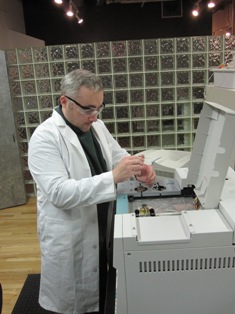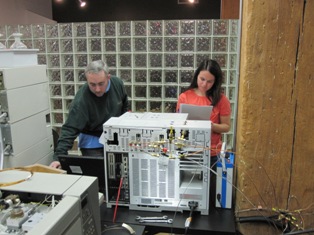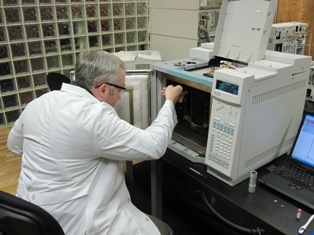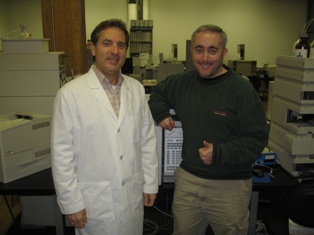First off what is Chromatography?
Chromatography is strictly and simply speaking "separation science". It is the study of how an analyst can take a complex matrix (compound) and separate it out into its component parts.
It is a relatively "new" form of analytical chemistry in that the first true use of modern chromatography is usually attributed to Russian botanist Mikhail Semyonovich Tsvet, who used columns of calcium carbonate for separating plant pigments during the first decade of the 20th century during his research of chlorophyll.
In is very basic nature, and grossly oversimplified, it involves passing a complex non-separated mixture presented to the machine in a "mobile phase" expelled through a stationary phase. The stationary phase separates the analyte to be measured from other molecules of a different type present in the mixture based on differential partitioning between the mobile and stationary phases (affinity). This results in differential retention time on the stationary phase and thus making the separation.
Say what?

Imagine you live at a house that has a driveway. At the bottom of this driveway you put a pile of different types of balls resting at the bottom of this inclined, paved driveway. This pile includes all different types and kinds of balls with different surface areas and textures such as ball bearings, marbles, ping pong balls, golf balls, wiffle balls, handballs, tennis balls, hockey pucks, baseballs, soccer balls, volley balls, basketballs, footballs, and bowling balls. You want to find the bowling ball so you can go bowling later in the afternoon, but you are blindfolded for some reason (stick with me here, it is just an analogy), You are not allowed to touch the group, but you have a tool to help separate them out. A leaf blower. So, you know that based upon its make up namely its weight the bowling ball will take a very powerful leafblower as opposed to say the wiffle ball. So, you attempt to move this motley collection of balls up the driveway with a normal leafblower. Some of the pile will quickly move to the top of the driveway immediately, some balls will migrate at varying speeds, and some balls may take an eternity to reach the end of the driveway just like our bowling ball.
The difference in the time that each type of ball takes to travel to the top depends upon the characteristics of each ball such as the surface area, the weight and so on. Obviously, the lighter balls travel more quickly. The heavier ones might take forever. Also, some balls may take longer due to their shape, like the hockey puck or the football. The different balls interact with each other as the air from the leaf blower acts on the pile. This interaction may hinder or accelerate the ball’s travel as the balls strike each other. The surface characteristics of the ball may be important, as in the examples of the tennis ball and golf ball.
What you are doing here is technically speaking separation science. You are separating out a complex mixture into its component parts.
What is Gas Chromatography?
Gas chromatography (GC) is a specific form of Chromatography. It is a separation technique in which the mobile phase is a gas.
Gas chromatography (GC) is based on a partition equilibrium of analyte between a solid stationary phase (often a liquid silicone-based material) and a mobile gas (most often Helium). The stationary phase is adhered to the inside of a small-diameter glass tube (a capillary column) or a solid matrix inside a larger metal tube (a packed column). The GC itself is a qualitative analytical method whereby if it alone is used, it can only tell that the characteristic is present by the retention time as compared against a known At best, using only a GC, you can tell that the suspect analyte is consistent with the characteristics of the known. It does not necessarily mean that it is the analyte until you use a detector of some level of analytical sensitivity,
How is it used in Pennsylvania DUI prosecution?
It is a whole blood analysis technique (in fact, it is the only direct form of whole blood analysis) used to separate out the analyte of interest (often times either alcohol or drugs of abuse). But what it really does is scare to death most DUI attorneys. It is hardcore science that most even experienced attorneys are scared to hear about.
Why is it so important in Pennsylvania DUI prosecution?
It drives a stake in the heart of many an experienced DUI attorney. In fact, most attorneys when those hear those dreaded words plead the case out.
I’m not one to be scared about GC results in Pennsylvania DUI arrests.
So, realizing that hospital blood testing was on its way out of use, I gathered up a bunch of my colleagues and we went to Chicago to take an American Chemical Society course entitled: "Gas Chromatography: Fundamentals, Troubleshooting, and Method Development". It was a week long hands-on laboratory course conducted through the American Chemical Society and instructed by Dr. Lee N. Polite, MBA, PhD of Axion Labs.

(Pictured: Pennsylvania DUI Attorney Justin McShane with the attorneys who participated in the Course on the left and on the right with all of the attendees)
According to the Course Description:
This course is designed for beginners and intermediate-level practitioners who want practical laboratory experience in gas chromatography (GC). The lectures—supplemented by problem sets, slides, and video presentations—provide the fundamentals needed to understand the technique and instrumentation involved in this powerful analytical tool. At the end of the class, you will have mastered the fundamentals of GC, participated in six hands-on laboratory sessions, performed reference and literature searches, and learned specialized techniques based on your specific interests.
.jpg)

(Pictured: Pennsylvania DUI Attorney Justin McShane prepares a direction injection and a run on the GC)
Boy was that an understatement! It was a great course. Here is why…
| Agenda | |
|
I took a lot away from it.
(Pictured: Pennsylvania DUI Attorney Justin McShane installs a capillary column)
But why bother?
We must remember that the Defendant has no burden to prove any facts in this proceeding at all. Instead, the burden of proof remains at all times with the Commonwealth and the evidence presented must always prove guilt beyond a reasonable doubt or the Defendant maintains the presumption of innocence and the result must be not guilty.
The blood result as reported by the Government must be PROVEN as reliable, accurate, precise, repeatable, traceable, verified and true. It is a matter of fact that the Jury must resolve and it be proven to all of them and they must be satisfied of this fact beyond a reasonable doubt. Otherwise, the Defendant maintains the presumption of innocence and the result must be not guilty.
In order for a Blood Alcohol Concentration as measured by blood to be reliable, accurate, precise, repeatable, traceable, verified and true and to form the basis for a conviction, there must be a full examination of all of the evidence.
A very good Pennsylvania DUI attorney during the trial will be able to point out that in determining the reliability or veracity of the reported BAC it is essential to have all of the information concerning the pre-collection storage of the kit, the blood collection itself, the transportation and storage of the specimen, the type of analysis, the method of the analysis, and the accuracy, calibration and reliability of the analyzing instrument. Further, it is well-known that in order to have a truly valid and reliable result, the specimen must be handled in a specific way, including:
- The pre-collection storage of the specimen kit must be maintained within tolerance and per the manufacturer,
- The blood collection itself must be performed in a specified manner,
- The handling of the specimen post-collection must be performed in a specified manner,
- The transportation and storage of the specimen post-collection must be performed in a specified manner,
- The preparation of the specimen before the analysis must be done in a specified manner,
- The instrument used to analyze the specimen must be set up in a specific way.
- The instrument used must be maintained in a specific way,
- The analyst must know what he she is doing and must be tested in terms of his/her proficiency.
- The instrument used to analyze the specimen must be calibrated and checked for accuracy and precision,
- The pre-analysis preparation of the sample itself must be performed in a specified manner
- The analysis itself must be performed in a specified manner, and
- The reporting of the specimen as tested must be performed in a specified manner.
These and many other issues are essential for the proper determination of the reliability, accuracy, precision, repeatability, traceability, verification and the truth of the blood alcohol results.
Thank you to Dr. Lee N. Polite, MBA, PhD.
(Pictured: PA DUI Attorney Justin McShane with Dr. Polite at the ACS Short Course in Gas Chromatography)
-Justin J. McShane, Esquire, Pennsylvania DUI Attorney
I am the highest rated DUI Attorney in PA as Rated by Avvo.com
You can follow me on Twitter , Facebook or Linkedin.




Erik Brown says:
After having taken a week long course on GC fundamentals, trouble shooting and method development, you are probably better trained and more qualified than most forensic scientists employed in crime labs!